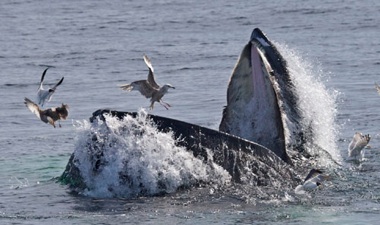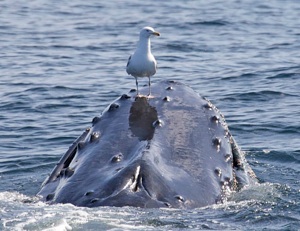Take a look at these awesome photos of the humpback whales .. amazing.
SnotBot DR Blog 3 – Everything we had hoped for!
It gives me great pleasure to advise you that our last 3 days on the water have been fantastic, each day better than the previous. The weather has fallen into a typical trade wind scenario, calm in the early morning and picking up as the day goes on. We were on the boat this morning by 6:15 and had the pleasure of watching a sunrise at sea (with a whale of course).
Today we had our 1st sample by 7:15 am and had our 9th sample by 9:00 am, by 12:30 (when the winds picked up) we had collected a total of 14 samples bringing our expedition total to 54. Our goal was 50 samples, so we are now ahead of the game with 3 days to go. As the sun rose we were with a mother, calf and escort, we collected two Snot samples from each whale so we could have comparable samples, then we collected another sample from each whale flying at a higher altitude than the first set so that we can try to determine what effect height might have on the success/productivity of the biological data (snot) that gets onto the dish.
Angie Sremba is here from Dr. Scott Bakers lab at Oregon State, Angie has been focusing on the DNA analysis. She brought us some exciting information with regards to how our biological data capabilities have (successfully) evolved over time. It is important to remember here that part of this whole process is developing the collection tools and protocols and while Dr. Bakers lab is developing the preservation and analysis protocols. In summary 2016 we had a 39% success rate with regards to sexing the animals from the DNA and a 55% success rate on the mitochondrial DNA. In 2018 we had a 92% success rate with regards to sexing the animals from the DNA and a 96% success rate with the mitochondrial DNA. This is clearly exciting as it demonstrates that we are learning and getting better on all fronts.
Another exciting data point today was the collection of some whale feces, the whales here are not feeding so it is unusual to find feces in this location. I think this is another amazing benefit of using drones for whale research, the drone saw the whale defecation (look very carefully for the brown stain in the last photo) and Britta and Andy were ready to collect it. This will prove invaluable in trying to put into context the hormone levels that we collect in the blow. We had a number of fun whale moments today but one of the best ones was a mother and calf lob tailing together (lifting their tails up and crashing them down onto the water). The mother would throw her tail down with an enormous crash and then the baby would do the same hardly making a splash. Andy caught one of these moments on camera (see attached photo).
Today we also did some sea trials with EarBot, after this expedition I will have four days at home and then Chris and I go to Cabo San Lucas with EarBot to work on a BBC special, so we need to make sure that EarBot is in tip top shape.
Last but not least I am happy to report that this blog is supported by some amazing photos from Christian Miller and Andy Rogan.
Best Fishes from the DR.
Iain
Iain Kerr
Cell: 978 760 1784



















